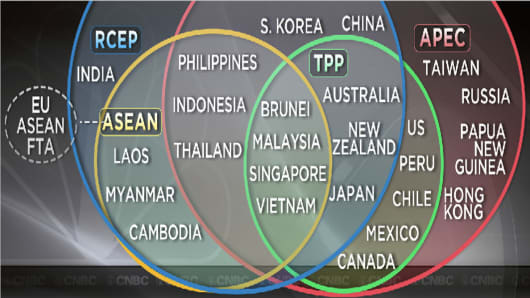RCEP: The next trade deal you need to know about
Oct 15, 2015
The conclusion of the Trans-Pacific Partnership (TPP) trade agreement last week could speed up talks on its lesser-known Asia-wide equivalent, trade analysts say.
Negotiators working on the Regional Comprehensive Economic Partnership (RCEP) are currently in the middle of a week-long meeting, the 10th of its kind, in Busan, South Korea.
"I am not 100 percent sure whether the RCEP deal will be struck as soon as this week but the stakes are now higher for RCEP members, especially those that are not in the TPP, because they realize that they are losing out," said Kaewkamol Pitakdumrongkit, assistant professor at the S. Rajaratnam School of International Studies (RSIS), Nanyang Technological University (NTU).
"This mindset of ’losing out’ could tempt these non-TPP countries in RCEP to reach a deal very soon," she added in an email interview with CNBC.
Deborah Elms, executive director at Asia Trade Centre, agrees: "The TPP has been viewed [with a fair amount of skepticism] by many of the RCEP countries. They were working towards a deadline at the end of the year ... but they were not under a great deal of pressure. Now that the TPP is closed, I think the pressure for some kind of high quality result out of RCEP is likely to mount."
According to South Korea’s Ministry of Trade, Industry and Energy, countries participating in the regional free trade deal will this week discuss guidelines for market liberalization and draw up a list of products to be liberalized for each country. Other trade issues, including economic cooperation, legal systems, trade barriers and e-commerce will also be on the agenda.
"We are not sure what the outcome will be at this stage, but we hope there will be good progress. Expectations are high. This is an important and critical round as we will be reporting to the leaders at the ASEAN Summit next month," a Malaysian official attending the Busan meeting told the country’s English newspaper The Star on Monday.

In a nutshell: The RCEP was conceived in 2013 and is being negotiated between the 10 member states of the Association of Southeast Asian Nations (ASEAN) plus regional trading partners including Australia, China, India, Japan, New Zealand and South Korea.
ASEAN is a regional organization established on August 8, 1967, that comprises Indonesia, Malaysia, Philippines, Singapore, Thailand, Brunei, Vietnam, Laos, Myanmar and Cambodia.
The RCEP aims to establish deeper economic cooperation between ASEAN and its regional trading partners, with a focus on trade in goods, services and investment. If signed, the regional free trade agreement will create an economic bloc with a combined population of 3.4 billion and trade volume of $10.6 billion, accounting for nearly 30 percent of the world’s trade, according to a statement released by South Korea’s trade ministry this week.
China has been seen as the key driver of the regional trade pact, which is viewed as an alternative to the U.S.-led TPP agreement, from which the world’s second-biggest economy was excluded.
Within the RCEP, seven countries - Australia, Japan, Malaysia, New Zealand, Singapore, Vietnam and Brunei - are part of the 12-nation TPP deal.
Hurdles to a deal: By most accounts, a deal is not likely to be signed this week due to a combination of technical difficulties and domestic politics.
"RCEP’s agenda includes discussions about intellectual property rights (IPRs), e-commerce, etc. Do all RCEP members have the same IPRs or e-commerce environment? I don’t think so. Then how can we develop rules which are compatible or applicable to all members? That’s a technical challenge," NTU’s Pitakdumrongkit noted.
"Secondly, in every international agreement, each participating nation inevitably faces the tension between a temptation to achieve joint cooperation where mutual gains can be reaped, and a temptation to serve particular national interests. RCEP members are facing this same tension," she added.
Asia Trade Centre’s Elms notes that a "lack of enthusiasm" for trade liberalization in countries such as India and Indonesia is "creating headaches for the more ambitiously-minded countries in the grouping."
Who stands to benefit: According to Asia Trade Centre, China will be a "big beneficiary" if the RCEP sees a successful conclusion.
"If you’re not in the TPP and you don’t have agreements with the European Union, that’s a bit alarming [because] your major trading partners are not connected to you. So [China] will want to make sure that the supply chains in Asia work to their benefit as much as possible," Elms said.
According to a commentary by Ma Jun, the chief economist of the People’s Bank of China (PBOC), that was published in the officialShanghai Securities News last Friday, China could forfeit a 2.2 percent boost to gross domestic product (GDP) if Beijing doesn’t join the TPP.
Meanwhile, the agreement, if concluded, could give China a leg-up in its push for regional influence.
"A TPP or RCEP deal will allow either Washington or Beijing to act as a regional agenda-setter, shaping the architecture of economic cooperation in the Southeast and East Asian regions, and helping secure economic interests," wrote Oliver Stuenkel, assistant professor of international relations at the Getulio Vargas Foundation (FGV).
Other Southeast Asian countries that are excluded from the TPP pact also stand to gain from RCEP, but the extent and breadth of benefits will hinge on the "quality" of the final agreement, analysts say.
"Some of the ASEAN countries that are not in the TPP really need to have a higher quality outcome in RCEP [in order] to sustain the competitiveness of their own economies and the region as a whole," Elms told CNBC.
Source: CNBC